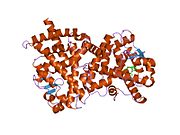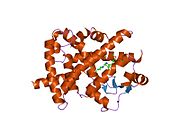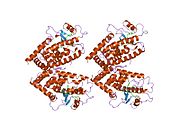Peroxisome proliferator-activated receptor gamma
| View/Edit Human | View/Edit Mouse |
Peroxisome proliferator-activated receptor gamma (PPAR-γ or PPARG), also known as the glitazone reverse insulin resistance receptor, or NR1C3 (nuclear receptor subfamily 1, group C, member 3) is a type II nuclear receptor functioning as a transcription factor that in humans is encoded by the PPARG gene.[5][6][7]
Tissue distribution
PPARG is mainly present in adipose tissue, colon and macrophages. Two isoforms of PPARG are detected in the human and in the mouse: PPAR-γ1 (found in nearly all tissues except muscle) and PPAR-γ2 (mostly found in adipose tissue and the intestine).[8][9]
Gene expression
This gene encodes a member of the peroxisome proliferator-activated receptor (PPAR) subfamily of nuclear receptors. PPARs form heterodimers with retinoid X receptors (RXRs) and these heterodimers regulate transcription of various genes. Three subtypes of PPARs are known: PPAR-alpha, PPAR-delta, and PPAR-gamma. The protein encoded by this gene is PPAR-gamma and is a regulator of adipocyte differentiation. Alternatively spliced transcript variants that encode different isoforms have been described.[10]
The activity of PPARG can be regulated via phosphorylation through the MEK/ERK pathway. This modification decreases transcriptional activity of PPARG and leads to diabetic gene modifications, and results in insulin insensitivity. For example, the phosphorylation of serine 112 will inhibit PPARG function, and enhance adipogenic potential of fibroblasts.[11]
Function
PPARG regulates fatty acid storage and glucose metabolism. The genes activated by PPARG stimulate lipid uptake and adipogenesis by fat cells. PPARG knockout mice are devoid of adipose tissue, establishing PPARG as a master regulator of adipocyte differentiation.[12]
PPARG increases insulin sensitivity by enhancing storage of fatty acids in fat cells (reducing
PPARG promotes anti-inflammatory M2 macrophage activation in mice.[14]
Adiponectin induces ABCA1-mediated reverse cholesterol transport by activation of PPAR-γ and LXRα/β.[15]
Many naturally occurring agents directly bind with and activate PPAR gamma. These agents include various
During embryogenesis, PPARG first substantially expresses in interscapular brown fat pad.[23] The depletion of PPARG will result in embryonic lethality at E10.5, due to the vascular anomalies in placenta, with no permeation of fetal blood vessels and dilation and rupture of maternal blood sinuses.[24] The expression PPARG can be detected in placenta as early as E8.5 and through the remainder of gestation, mainly located in the primary trophoblast cell in the human placenta.[23] PPARG is required for epithelial differentiation of trophoblast tissue, which is critical for proper placenta vascularization. PPARG agonists inhibit extravillous cytotrophoblast invasion. PPARG is also required for the accumulation of lipid droplets by the placenta.[11]
Interactions
Peroxisome proliferator-activated receptor gamma has been shown to
Research
PPAR-gamma
Many
See also
References
- ^ a b c GRCh38: Ensembl release 89: ENSG00000132170 – Ensembl, May 2017
- ^ a b c GRCm38: Ensembl release 89: ENSMUSG00000000440 – Ensembl, May 2017
- ^ "Human PubMed Reference:". National Center for Biotechnology Information, U.S. National Library of Medicine.
- ^ "Mouse PubMed Reference:". National Center for Biotechnology Information, U.S. National Library of Medicine.
- PMID 7787419.
- PMID 8702406.
- S2CID 2240461.
- PMID 9228052.
- PMID 27777310.
- ^ "Entrez Gene: PPARG peroxisome proliferator-activated receptor gamma".
- ^ PMID 16753211.
- ^ PMID 23652116.
- PMID 23177620.
- ^ PMID 23061409.
- S2CID 203413137.
- S2CID 10746292.
- PMID 16154383.
- S2CID 30996954.
- PMID 16213464.
- S2CID 22671555.
- PMID 17896990.
- S2CID 232300877.
- ^ PMID 10549290.
- S2CID 54322301.
- PMID 12040021.
- S2CID 20343538.
- PMID 10882139.
- ^ PMID 12479814.
- ^ PMID 10944516.
- S2CID 19487189.
- PMID 10347167.
- PMID 11696534.
- PMID 14636573.
- PMID 10558993.
- S2CID 221017099.
- S2CID 18526710.
- S2CID 12296573.
- PMID 16644654.
This article incorporates text from the United States National Library of Medicine, which is in the public domain.

























